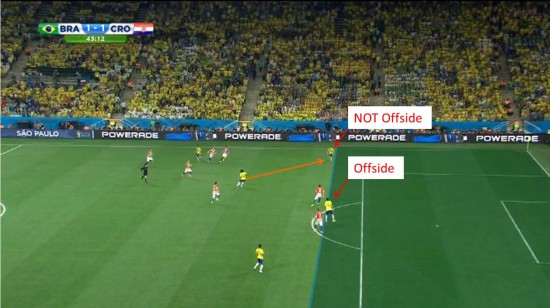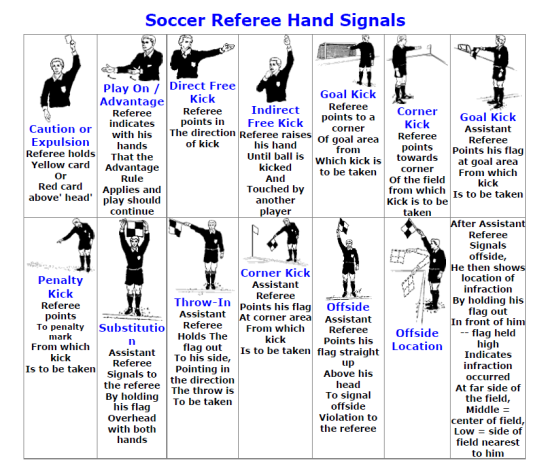Five rules youth soccer parents get wrong at every game
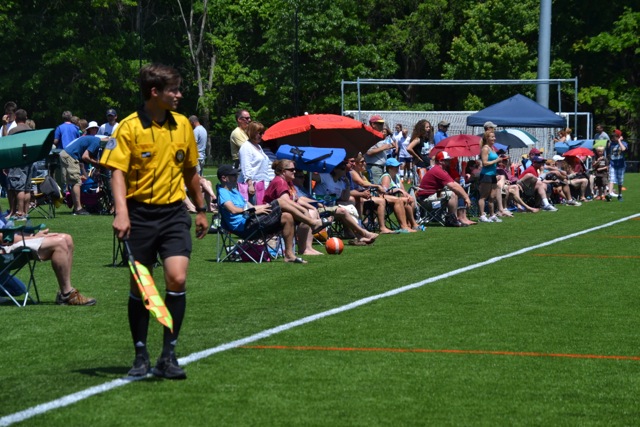
(Originally Published in December 2015)
The saying goes…
“Players win games. Coaches lose games. Referees ruin games.”
But in most youth games, you could easily add:
“…Parents embarrass themselves at every game.”
Parents all know they’re not supposed to yell at referees. But despite the best intentions in the car on the way to the game, once the whistle blows, those plans can quickly go out the window far too often in the stands or on the sidelines of fields and gyms all over the world.
At some point, every parent blurts something out, cheers the wrong “call,” or jumps in on the boo chorus that often spreads without anyone really understanding exactly what just happened.
It’s certainly human nature to be disappointed when things don’t go your way… and with our kids it can be much harder to really be objective. But when we criticize referees, it very rarely has a positive outcome. You’re never going to get a call changed.
The only thing worse than criticizing a referee for one of their mistakes is criticizing them when it’s actually YOU who are wrong.
So before you attend your next game, be sure you know these five commonly misunderstood rules. Your new and improved “Soccer IQ” may just help swing things your way:
1. Offside
The “interpretation” of offside (not offsides as some referees will remind you) is worthy of an entire book on an annual basis, so we can’t dig too deep here on that nuance. A majority of the debate takes place around interpreting if the alleged offending player was “actively involved” in the play.
Even at the professional level, different referees interpret this differently, with some waiting for a player to physically touch the ball, while others still raise the flag as soon as the player runs in the general direction of the ball.
Much of that nuance is debated in referee circles and with players on the field. At a much simpler level, the biggest mistake made by the majority of youth soccer parents at local games is even really understanding the rule about where a player can be “when the ball is played” that makes them eligible to be called offside at all.
Images like the one above don’t help a much for a live game, but if you look closely you can see the player in the act of kicking the ball forward.
He is playing it to the onside player, but had he done so towards the offside player then the odds of the flag going up are high… even though per “actively involved” rules the call REALLY depends on what that offside “position” player does once the ball is played! If he stops his run and raises his hand, then other players coming from onside positions are able to pursue the ball without a call being made.
What the image above does show is the BEST angle to make a judgement of offside eligibility. The angle is 90 degrees from the touchline to the second-to-last defender. (The goalkeeper is usually the last defender… but nothing in the rules says one of the two defenders playing the other team onside HAS to be a goalkeeper.)
Before you yell “offside, ref!” the next time, ask yourself: how many times you are REALLY looking at the second-to-last defender from this 90-degree angle at the exact time the ball is played in the direction of an attacking player?
If so, then consider: were you REALLY looking AT the last defender and listening for the thump of the ball (which remember also takes time to travel to your ears)? Most people — other than the assistant referee running the sidelines — watch the ball. And if you were doing the same, then by the time you turn your gaze towards the offensive player, he/she may be behind the second-to-last defender at that time, but were not “at the time the ball was played.”
For all of the reasons above, it’s really best just to let the assistant referee and referee decide on these calls and save your protests for another time. They’ll miss the close ones sometimes, but they’ll miss them both for and against your team pretty equally.
2. Ball out of play
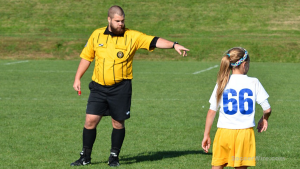 Judging whether a ball is out or not seems simple enough on paper, but can be super hard to judge at full speed. For those coming from other sports, where the play is “out” if a player or ball touches a line, this rule, even on paper, needs a little getting used to.
Judging whether a ball is out or not seems simple enough on paper, but can be super hard to judge at full speed. For those coming from other sports, where the play is “out” if a player or ball touches a line, this rule, even on paper, needs a little getting used to.
To be clear: In soccer, the “whole ball must be over the whole line” to be out. And that line of course extends infinitely upward as an invisible plane that can be broken by a ball, but not surpassed completely.
Once you’re sure you know the rule, unless you are “looking straight down the line” like the end zone camera in American football, you can’t really be sure. And even with this view, most often on the “close ones,” a player or assistant referee’s foot can all block your view at that critical fraction of a second!
Even assuming perfect position and no obstructions of your view (and that you didn’t blink at the wrong time) there’s still the geometry of the thing.
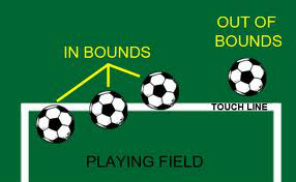
The ball is round.
While it’s pretty easy to judge looking straight down from the top like in the image above, when you’re looking from a lower point of view (and from any angle not directly “down the line”) it is very possible for the ball to not be physically touching the line on the ground, but for the outer edges of its widest point to STILL be hanging over the outer plain of the line.
+READ: Five mistakes soccer parents make with their players
In other words, even if you see green between where the ball is touching the ground and the line itself, the ball can easily still be inbounds. Standing a few yards back from the line as a fan, the ball can looks out because your eye sees this green space — especially on synthetic turf fields where only about 5% of the ball’s surface area is in any contact with the field at all.
3. Handling
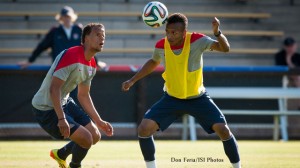 This rule is one of the hardest for a referee to judge with even more nuance… and room for interpretation… and more opportunities for obstructed views than offside or out-of-play decisions.
This rule is one of the hardest for a referee to judge with even more nuance… and room for interpretation… and more opportunities for obstructed views than offside or out-of-play decisions.
In short, the hand (arm) must “play the ball,” not the “ball to hand.” This means the ball can touch a player’s arm, but if it’s not really their fault, it’s not a foul. But what is their fault? Did they stand with their arms raised like someone was aiming a gun? Or were their arms just in a natural running position?
And where did the ball come from? Was it shot toward them from one yard away and it deflected up off their knee to an arm that was outstretched in the motion of lunging (have you ever tried lunging while keeping your arms down?)
With all of these nuances, it’s no wonder many professional referees even disagree on calls when they review matches on video after matches. Yet “handball” is the most commonly heard shouts towards referees from parents at any game — and always from parents supporting the team opposite of the one whose arm touched the ball.
In short, handling must be intentional to be called. It’s up to referees to judge intent, with the most egregious levels of intent actually warranting a caution.
4. Advantage
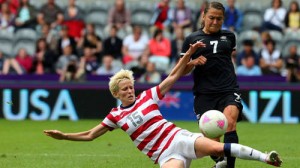 This is a “rule” that favors more than it hurts when called, yet so many parents completely miss it in the big picture of the game.
This is a “rule” that favors more than it hurts when called, yet so many parents completely miss it in the big picture of the game.
Yes, your son or daughter may have just been crushed by a late tackle as they passed the ball, but if their pass makes it to a teammate with time and space on the ball — especially in the attacking half of the field — then you really DON’T want to hear to the referee’s whistle, do you?
Referees are advised to yell “play on” and raise both arms forward when they acknowledge a foul occurred, but they are choosing not to stop the play because calling the foul would have actually have taken a good advantage away from the aggrieved team.
If the foul was bad enough, the referee will return to the offending player at the next natural stoppage of play and eject, caution, or give them a stern talking-to. If not, then literally “no harm, no foul.”
+READ: When should soccer players change teams?
A lot of referees at the youth level don’t actually wait long enough to see a play develop after a foul to look for advantage. In that case, given the lost potential for the team with the ball, it’s the relative lack of protest from the sidelines when a referee stops a play that should have continued is equally revealing of an ignorance of the rules. This is one of those times when coaches and players will protest vigorously while the sidelines are quiet.
5. Direct vs. Indirect
What happens after the whistle blows — or what can happen — is another often misunderstood occurrence.
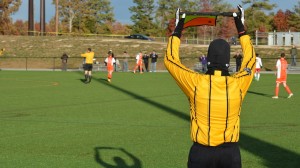 Does a team get a direct or indirect free kick? The rules are clear as to which offense earns the appropriate result. Generally, fouls that involve player-on-player offenses are direct, while procedural offenses are indirect. Handling is also direct.
Does a team get a direct or indirect free kick? The rules are clear as to which offense earns the appropriate result. Generally, fouls that involve player-on-player offenses are direct, while procedural offenses are indirect. Handling is also direct.
But what does that mean?
A direct free kick simply means the ball can count as a goal if it goes directly in the opponent’s goal without touching another player first.
An indirect free kick (or throw-in) means the ball must touch another player (on either team) before entering the opponent’s goal in order for it to count. If it does so without that second touch, then it’s just a goal kick for the defending team.
How do you know which one was awarded during the game? This is the part most parents miss even if they generally understand the concept. Many youth players often even don’t realize this (as evidenced by their having to ask the referee), but the answer is pretty simple.
For an indirect kick award, the referee holds their arm straight up until that second touch occurs — meaning the team cannot score until their arm is taken down.
For a direct kick award, they point towards the goal of the team committing the foul while they blow their whistle, but will put their arm down from that point.
The only exceptions in “indirect” situations are throw-ins and a dropped ball. Neither of these can be scored directly without another player touching the ball, but the referees don’t hold their arm up on those. It’s supposed to just be known.
—
We hope this helps the next game you watch go more smoothly! If there are other rules you don’t understand, please comment below or send us a tweet @TheSoccerWire.
And remember, the one thing that that will help improve the quality of refereeing at future games is simply the referee assignors having more referees to choose from! Some referees — like coaches, players, and parents — are simply not very good. But no amount of yelling will change that 10 minutes into your next game.
The youth soccer “boom” started in the 1980s, so there should be plenty of 30- to 50-year-old former players whose playing careers have wound down who would make great referees. If you’re one of those who finds yourself continually frustrated, take a class and get out there yourself — for the good of the game!
SOCCERWIRE MARKETPLACE
- The St James FC Boys Travel Tryouts
- OFFICIAL BAYERN MUNICH SUMMER CAMPS U.S.
- JOIN THE ALLIANCE!
- OFFICIAL FC BARCELONA CAMPS U.S.
- The Cup San Diego - Hosted by Legends FC
- Players Wanted - Undergraduate or Post-graduate
- Head Coach - South Region at The St. James FC
- Travel Coach - North Region at The St. James FC
- Program Manager - Chantilly at The St. James FC
- Girls Director of Player Development: South Region

